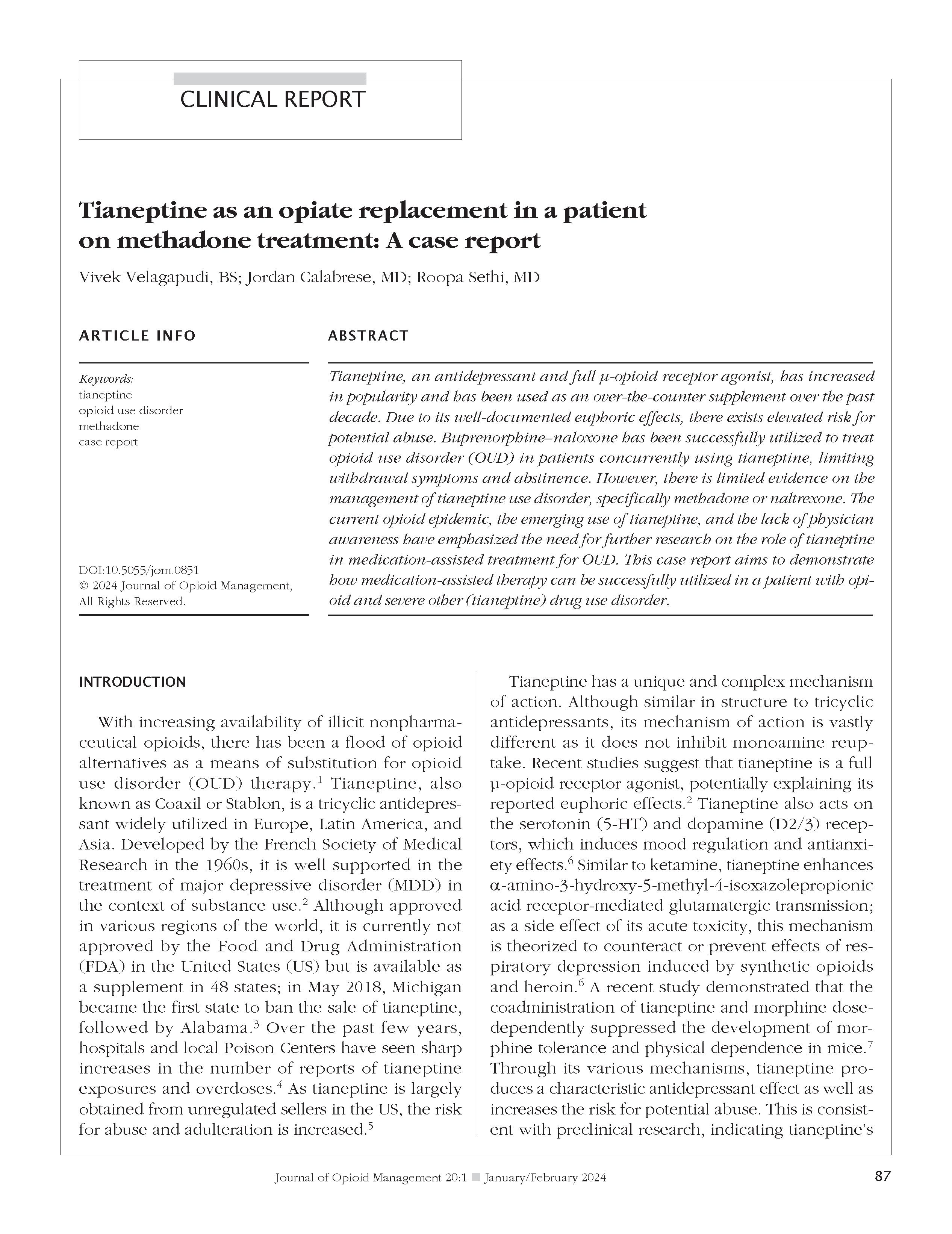Tianeptine as an opiate replacement in a patient on methadone treatment: A case report
DOI:
https://doi.org/10.5055/jom.0851Keywords:
tianeptine, opioid use disorder, methadone, case reportAbstract
Tianeptine, an antidepressant and full μ-opioid receptor agonist, has increased in popularity and has been used as an over-the-counter supplement over the past decade. Due to its well-documented euphoric effects, there exists elevated risk for potential abuse. Buprenorphine–naloxone has been successfully utilized to treat opioid use disorder (OUD) in patients concurrently using tianeptine, limiting withdrawal symptoms and abstinence. However, there is limited evidence on the management of tianeptine use disorder, specifically methadone or naltrexone. The current opioid epidemic, the emerging use of tianeptine, and the lack of physician awareness have emphasized the need for further research on the role of tianeptine in medication-assisted treatment for OUD. This case report aims to demonstrate how medication-assisted therapy can be successfully utilized in a patient with opioid and severe other (tianeptine) drug use disorder.
References
Szczesniak L, Sullivan R: Microdose induction of buprenorphine in a patient using tianeptine. J Addict Med. 2022; 16(6): 736-738. DOI: 10.1097/ADM.0000000000001003. DOI: https://doi.org/10.1097/ADM.0000000000001003
National Center for Biotechnology Information: PubChem compound summary for CID 68870, tianeptine. Available at https://pubchem.ncbi.nlm.nih.gov/compound/Tianeptine. Accessed March 29, 2023.
Trowbridge P, Walley AY: Use of buprenorphine-naloxone in the treatment of tianeptine use disorder. J Addict Med. 2019; 13(4): 331-333. DOI: 10.1097/ADM.0000000000000490. DOI: https://doi.org/10.1097/ADM.0000000000000490
Baird TR, Akbarali HI, Dewey WL, et al.: Opioid-like adverse effects of tianeptine in male rats and mice. Psychopharmacology (Berl). 2022; 239(7): 2187-2199. DOI: 10.1007/s00213-022-06093-w. DOI: https://doi.org/10.1007/s00213-022-06093-w
Lauhan R, Hsu A, Alam A, et al.: Tianeptine abuse and dependence: Case report and literature review. Psychosomatics. 2018; 59(6): 547-553. DOI: 10.1016/j.psym.2018.07.006. DOI: https://doi.org/10.1016/j.psym.2018.07.006
Algera H, van der Schrier R, Cavalla D, et al.: Respiratory effects of the atypical tricyclic antidepressant tianeptine in human models of opioid-induced respiratory depression. Anesthesiology. 2022; 137(4): 446-458. DOI: 10.1097/ALN.0000000000004324. DOI: https://doi.org/10.1097/ALN.0000000000004324
Chu CC, Shieh JP, Shui HA, et al.: Tianeptine reduces morphine antinociceptive tolerance and physical dependence. Behav Pharmacol. 2010; 21(5-6): 523-529. DOI: 10.1097/FBP.0b013e32833db7d4. DOI: https://doi.org/10.1097/FBP.0b013e32833db7d4
Camenga DR, Colon-Rivera HA, Muvvala SB: Medications for maintenance treatment of opioid use disorder in adolescents: A narrative review and assessment of clinical benefits and potential risks. J Stud Alcohol Drugs. 2019; 80(4): 393-402. DOI: https://doi.org/10.15288/jsad.2019.80.393
Gagnier JJ, Kienle G, Altman DG, et al.: The CARE guidelines: Consensus-based clinical case reporting guideline development. Headache. 2013; 53(10): 1541-1547. DOI: 10.1111/head.12246. DOI: https://doi.org/10.1111/head.12246
American Psychiatric Association: Diagnostic and Statistical Manual of Mental Disorders: DSM-5. Washington, DC: American Psychiatric Association, 2013. DOI: https://doi.org/10.1176/appi.books.9780890425596
Wesson DR, Ling W: The Clinical Opiate Withdrawal Scale (COWS). J Psychoactive Drugs. 2003; 35(2): 253-259. DOI: 10.1080/02791072.2003.10400007. DOI: https://doi.org/10.1080/02791072.2003.10400007
Vandel P, Regina W, Bonin B, et al.: Abuse of tianeptine. A case report. Encephale. 1999; 25(6): 672-673.
Khazaeli A, Jerry JM, Vazirian M: Treatment of kratom withdrawal and addiction with buprenorphine. J Addict Med. 2018; 12(6): 493-495. DOI: 10.1097/ADM.0000000000000435. DOI: https://doi.org/10.1097/ADM.0000000000000435

Published
How to Cite
Issue
Section
License
Copyright 2005-2025, Weston Medical Publishing, LLC and Journal of Opioid Management. All Rights Reserved.










